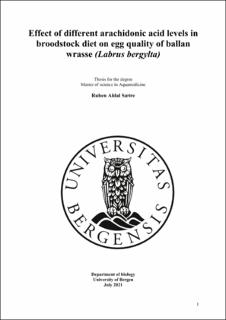Effect of different arachidonic acid levels in broodstock diet on egg quality of ballan wrasse (Labrus bergylta)
Master thesis
Permanent lenke
https://hdl.handle.net/11250/2788833Utgivelsesdato
2021-07-31Metadata
Vis full innførselSamlinger
- Master theses [257]
Sammendrag
The production of ballan wrasse (Labrus bergylta) is growing and is becoming a focus area for the aquaculture industry. As a result of rising louse numbers and problems with resistance, biological methods such as cleaner fish is being introduced and used in aquaculture. Our project focused on improving the health of cleaner fish and develop a method for estimating number of eggs spawned. For this captive ballan wrasse broodstock was fed with different levels of Arachidonic acid to investigate the effect on eggs. When analyzing it seems that an ARA level of total fatty acids closes to the medium ARA diet (approximately 2,3 % of total fatty acids) is the best for an optimum broodstock diet for production of eggs. ARA added in feed also seems to help the fish recover from some diseases and improve their health status. A subjective method for determining the number of eggs was also developed, and image analysis was used and compared to regular eye-scoring results. Eggs were weighted and counted to verify estimation methods and suggest that the image analysis is more accurate. Both methods produced rough estimates, but larger sampling size could increase the accuracy. Additionally, eye scoring with a power adaption yielded similar estimates and could be a useful tool for the ballan wrasse farmers to better estimate egg production. The production of ballan wrasse (Labrus bergylta) is growing and is becoming a focus area for the aquaculture industry. As a result of rising louse numbers and problems with resistance, biological methods such as cleaner fish is being introduced and used in aquaculture. Our project focused on improving the health of cleaner fish and develop a method for estimating number of eggs spawned. For this captive ballan wrasse broodstock was fed with different levels of Arachidonic acid to investigate the effect on eggs. When analyzing it seems that an ARA level of total fatty acids closes to the medium ARA diet (approximately 2,3 % of total fatty acids) is the best for an optimum broodstock diet for production of eggs. ARA added in feed also seems to help the fish recover from some diseases and improve their health status. A subjective method for determining the number of eggs was also developed, and image analysis was used and compared to regular eye-scoring results. Eggs were weighted and counted to verify estimation methods and suggest that the image analysis is more accurate. Both methods produced rough estimates, but larger sampling size could increase the accuracy. Additionally, eye scoring with a power adaption yielded similar estimates and could be a useful tool for the ballan wrasse farmers to better estimate egg production.
